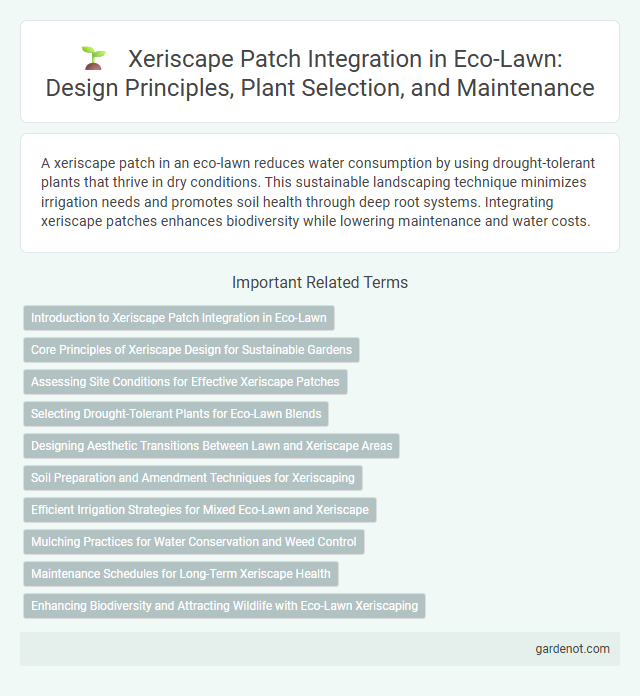A xeriscape patch in an eco-lawn reduces water consumption by using drought-tolerant plants that thrive in dry conditions. This sustainable landscaping technique minimizes irrigation needs and promotes soil health through deep root systems. Integrating xeriscape patches enhances biodiversity while lowering maintenance and water costs.
Introduction to Xeriscape Patch Integration in Eco-Lawn
Xeriscape patch integration in eco-lawn emphasizes water-efficient landscaping by combining drought-tolerant plants with sustainable lawn care practices. This technique reduces irrigation needs, promotes biodiversity, and minimizes maintenance costs while maintaining aesthetic appeal. Incorporating native and adaptive species in xeriscape patches supports soil health and conserves valuable water resources in eco-friendly yard designs.
Core Principles of Xeriscape Design for Sustainable Gardens
Xeriscape design centers on seven core principles: water-efficient landscaping, soil analysis and improvement, practical turf areas, appropriate plant selection, efficient irrigation, use of mulch, and thoughtful maintenance. These principles reduce water consumption by emphasizing drought-tolerant plants and optimizing irrigation methods within eco-lawns. Implementing xeriscape patches promotes sustainability by conserving resources and enhancing garden resilience in arid environments.
Assessing Site Conditions for Effective Xeriscape Patches
Assessing site conditions is crucial for creating an effective xeriscape patch that conserves water and thrives in arid climates. Key factors include soil type, drainage, sun exposure, and existing vegetation, which influence plant selection and landscape design. Analyzing these conditions ensures optimal plant health, reduces maintenance, and enhances the eco-lawn's sustainability.
Selecting Drought-Tolerant Plants for Eco-Lawn Blends
Xeriscape patches thrive by incorporating drought-tolerant plants like buffalo grass, blue grama, and creeping thyme, which reduce water consumption while maintaining aesthetic appeal in eco-lawn blends. Selecting native species such as blue grama enhances soil health and supports local biodiversity, promoting sustainability within urban landscapes. Integrating deep-rooted perennials optimizes water retention and durability, making these plants ideal for low-maintenance, eco-friendly lawn designs.
Designing Aesthetic Transitions Between Lawn and Xeriscape Areas
Designing aesthetic transitions between lawn and xeriscape areas involves using mulch beds, native drought-tolerant plants, and natural stone borders to create seamless visual flow while conserving water. Strategic placement of ornamental grasses and succulents softens edges, enhancing texture contrast and guiding the eye across spaces. Incorporating curvilinear lines instead of rigid borders supports a naturalistic appearance, blending eco-lawn zones with xeriscape patches effectively.
Soil Preparation and Amendment Techniques for Xeriscaping
Effective soil preparation and amendment techniques are crucial for xeriscape patches, ensuring optimal water retention and nutrient availability in arid environments. Incorporating organic matter such as compost or mulch improves soil structure and moisture-holding capacity, while soil texture adjustments with sand or clay optimize drainage and aeration. Testing soil pH and nutrient levels before planting guides precise amendments, promoting healthy xeriscape lawn establishment and sustainability.
Efficient Irrigation Strategies for Mixed Eco-Lawn and Xeriscape
Efficient irrigation strategies for mixed eco-lawn and xeriscape patches emphasize drip irrigation systems and smart controllers to optimize water usage and reduce runoff. Incorporating native drought-tolerant plants with deep root systems enhances soil moisture retention and minimizes supplemental watering needs. Soil moisture sensors and timed irrigation schedules ensure precise water application, promoting sustainable landscape health and conserving resources.
Mulching Practices for Water Conservation and Weed Control
Mulching practices in xeriscape patch designs significantly enhance water conservation by reducing soil evaporation and retaining moisture for extended periods. Organic mulches such as bark, wood chips, or compost not only suppress weed growth by blocking sunlight but also improve soil fertility as they decompose. Implementing strategic mulching techniques ensures sustainable eco-lawn management by minimizing irrigation needs and promoting healthy plant development in arid landscapes.
Maintenance Schedules for Long-Term Xeriscape Health
Xeriscape patches require a maintenance schedule that emphasizes deep, infrequent watering to promote drought-resistant root systems and reduces water consumption by up to 50%. Regular pruning of native and drought-tolerant plants every 6 to 8 weeks helps maintain air circulation and prevents disease. Seasonal inspection for soil health and mulching replenishment every spring ensures nutrient retention and long-term xeriscape vitality.
Enhancing Biodiversity and Attracting Wildlife with Eco-Lawn Xeriscaping
Eco-lawn xeriscaping with xeriscape patches significantly enhances biodiversity by providing native, drought-tolerant plants that create a thriving habitat for pollinators, birds, and beneficial insects. These eco-lawn areas reduce water consumption while supporting diverse wildlife, contributing to a resilient, sustainable ecosystem. Integrating xeriscape patches within eco-lawns fosters ecological balance by promoting natural plant communities and increasing local flora and fauna richness.
Xeriscape patch Infographic

 gardenot.com
gardenot.com